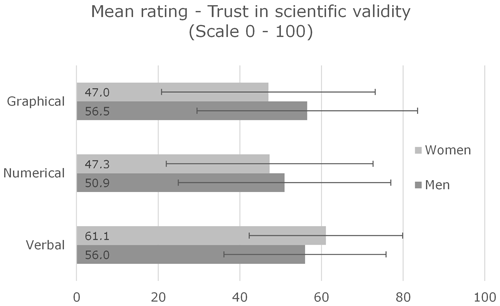Communicating scientific uncertainties
Communicating a message of scientific uncertainty to a general audience is difficult because laypeople usually lack the conceptual tools to understand uncertainty (e.g., quantification methods). In addition, uncertainties can lead to mistrust and can be misused to prevent or delay radioactive waste management. On the proposed poster, we report the results of an experimental study (N=177) that investigated preferences for and trust in different visualizations of simulation results and tested different modes of communication (verbal, numerical, and visual/graphical). The participants processed three different parts, namely (1) the variation in the form of presentation of a scientific result, (2) the variation in the sender/source of a scientific result in numerical format, and (3) a direct comparison of two representations of simulation results (deterministic and probabilistic). Besides socio-demographics, we used items to check for the potential impact of numeracy and verbal skills, the need for a cognition concept, and questions on science in general, as well as the acceptance of a potential deep-ground repository. The dependent variable in each part was the degree of trust in the scientific validity of the information. For an example result, see Fig. 1.
Clear influences of the non-dependent variables are only evident to a limited extent. Women rate their numerical abilities less highly than men do. There is no difference in verbal skills. The latter variable is also not explanatory, while numerical ability is relevant for the choice of the probabilistic variant and the corresponding trust rating in Experiment 3. The most striking result is that the attitude towards a deep geological repository for high-level nuclear waste (HLW; degree of acceptance) is the decisive parameter in all experimental conditions.
The oral presentation will focus on another challenge of uncertainty communication, namely unquantifiable model uncertainties. In a repository, these may arise from the heterogeneity of the host rock. One of these potential uncertainties may be an undetected fault parallel in the drift axis in clayey host rocks. At the Konrad site, an anchor failure in an infrastructure drift resulted from such a fault. To deal with this kind of uncertainty, a certain kind of flexibility is needed to react to such events. The talk should initiate a discussion on the importance of communicating these potential uncertainties and on the impact of these uncertainties on the repository program.





